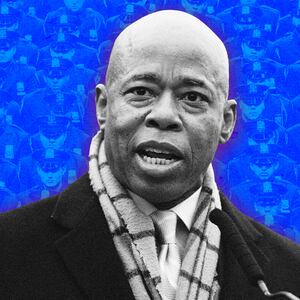In the summer of 2021, then Democratic mayoral nominee Eric Adams—a retired NYPD captain and former gadfly within the department who’d won a narrow victory in a crowded field on a promise to reform the police while re-establishing “public safety as the prerequisite to prosperity”—proclaimed himself “the new face of the Democratic Party.”
By the time Mayor Adams received his first paycheck in January—converting it into crypto in fulfillment of a sideshow promise he just happened to make right after quietly flying to Puerto Rico on a crypto billionaire’s private jet (he’s said he paid his own way but won’t release the receipts “as a matter of policy”)—violent crime was the dominant issue in New York City.
And violent crime may well prove a defining issue in the 2022 midterms for Democrats, who are holding their breath to see if New York City’s new mayor (a former Republican, by the way) can live up to his big promises, fast.
ADVERTISEMENT
In the city so far this January, Adams’ first month in office, five police officers have been shot and two of them killed; three people have been shoved onto subway tracks, resulting in two deaths; an 11-month-old girl was hit in the face by a stray bullet, and a 19-year-old was fatally shot while working the overnight shift at a Burger King.
That was the backdrop as Adams, who’d been the mayor in waiting since his primary win in June, finally laid out his policing plan in a serious and substantial speech on Monday. Adams, who’s talked a lot about finding the right balance between keeping people safe and preventing police abuses, spent some time on long-term or root-cause solutions, including more support for community “violence interrupters” and more services for the seriously mentally ill.
More immediately, he talked about getting more cops on the streets and in the trains, getting the court system working more quickly, and appointing new judges who want to keep violent criminals off of the streets. But the centerpiece of his plan is a new anti-gun unit to replace the one the NYPD disbanded on his predecessor Bill de Blasio’s watch amid the George Floyd protests and a push to cut the police budget.
“We will not surrender our city to the violent few,” Adams said. “I want to be clear: This is not just a plan for the future—it is a plan for right now.”
But a lot of what he talked about was outside his control, and not on a clock that will change the public safety picture in New York City, where murders and gun violence are way up compared to 2019. That’s part of a national trend, leading to a heated fight here about whether the increase is because of the pandemic or new state laws and city policies implemented by de Blasio.
Adams called on Albany to roll back some of its bail reforms, and to let judges consider a person’s dangerousness (New York is the only state where judges are barred from doing so). He also called on state lawmakers, who passed a “raise the age” law in 2017, to let teens involved in violent crime get charged as adults.
Albany, which is now fully controlled by Democrats, shrugged.
Assembly Speaker Carl Heastie suggested Adams should get city services in order before asking for changes to state law. Powerful state Sen. Michael Gianaris, who derailed the Amazon HQ2 deal, said the data didn’t support the idea that bail reform was responsible for the spike in violent crime here and accused the mayor of trying to “demagogue this issue rather than focus on real data.” And Gov. Kathy Hochul, who’s running for a term of her own this year and is in something of a political marriage of convenience with the newly elected mayor, declined to comment on the plan even as she called Adams her “public safety partner” in a tweet.
In his speech, Adams also railed about the “iron pipeline” that brings guns into New York City and called on Washington to do more to stop that flow, as every mayor before him has done to no avail. That’s a long-standing problem that doesn’t account for the sharp rise in gun violence and murders since 2019, and one where there’s clearly no cavalry coming.
To the contrary, the Supreme Court appears poised to strike down the city’s gun licensing rules this fall. That could make New York City feel a lot more like Chicago, where Indiana just across the river ensures a steady stream of legally purchased guns are used for violent crimes in the city.
Another thing that’s outside the city’s second Black mayor’s control is Manhattan’s first Black district attorney. Alvin Bragg, who was elected at the same time as Adams on a promise to fundamentally reform the prosecutor’s office, issued a much-attacked day one memo, in line with the promises he’d made as a candidate, to seek prison time only for a handful of violent crimes, as well as in political corruption cases.
While Adams has avoided any direct confrontation with Bragg, there’s a clear tension between the two newly elected officials’ agendas. The mayor’s new police commissioner made that clear in a memo of her own to the police department, saying she was “very concerned about the implications [of Bragg’s memo] to your safety as police officers, the safety of the public and justice for the victims.”
More broadly, there’s some fundamental tension between public safety and justice reform that reformers in particular are loath to acknowledge. Things like aggressive policing, dragnets, and incarcerating people ahead of their trials help in the short term to remove dangerous people, among others, from circulation. To try and find the “balance” he’s promised, Adams intends to use some of those problematic tools, as well as facial recognition technology.
So far, Adams has done a masterful job—on the campaign trail and during the transition and in his first few weeks as mayor—of messaging. He’s talked about the need to provide public safety that doesn’t feel like an occupation and he’s been showing up on the trains and meeting the press and the public in ways that his predecessors did not.
Speaking regularly and openly means he’s made some gaffes but also that he takes in lots of information and adjusts his rhetoric in response to it. For instance, Adams said shortly after 40-year-old Michelle Go was shoved into a train and killed at Times Square on a Saturday morning that “When you have an incident like this, the perception is what we’re fighting against. This is a safe system.”
He was trying to make the point that train shovings remain lightning-strike rare while avoiding the fact that assaults in the subway system are at their highest level since 1997, even as ridership has plummeted from its pre-pandemic levels.
Two days later, after getting ripped for claiming the problem was “perception,” Adams reversed himself. “On day one, I took the subway system, I felt unsafe,” he said. “I saw homeless everywhere. People were yelling on the trains. There was a feeling of disorder.”
Of course, no mayor wants to focus on what’s wrong in the city, but doing so is a sign of a mayor taking ownership of its problems rather than offering alibis for them. The question now is what Adams can do to make right what he says is wrong, and how much support he can generate from Democrats in Albany for that agenda. It's less about messaging now than managing.
In a grim sign of how difficult the task ahead will be, Adams delivered his gun violence plan on Monday, racing it out after 22-year-old Officer Jason Rivera and 27-year-old Officer Wilbert Mora were shot down, without warning, while responding to a domestic violence call in Harlem on Friday.
Rivera died that day. On Tuesday, less than 24 hours after Adams delivered his remarks, Mora died as well.
Obviously, Adams isn’t to blame for the tragedy, but everything that happens on a mayor’s watch belongs to them. That’s the job, that’s the deal. And that means this new mayor doesn’t have much time at all to live up to his big promises to change things for the better, “right now.”
If Eric Adams can’t rapidly reverse the widespread sense of a more dangerous and disorderly city, he won’t need to keep promoting himself as the face of the Democratic Party. Republicans will do that for him ahead of the midterms.







